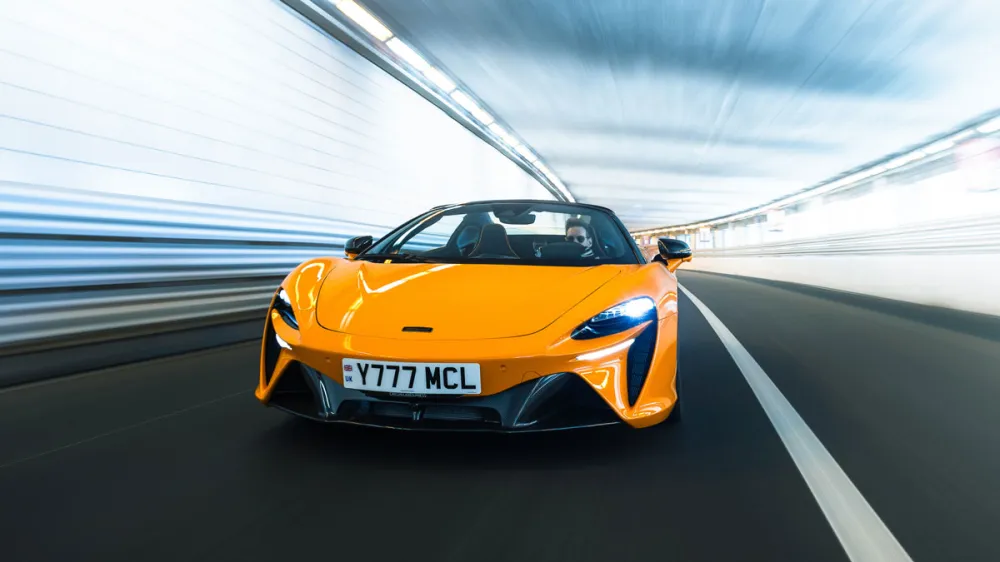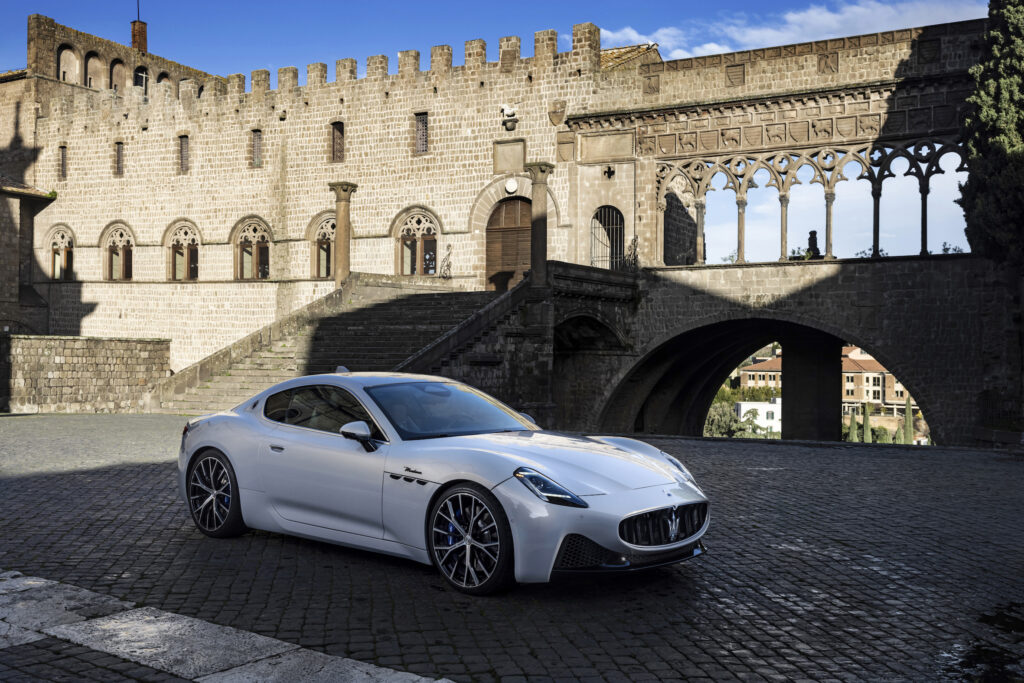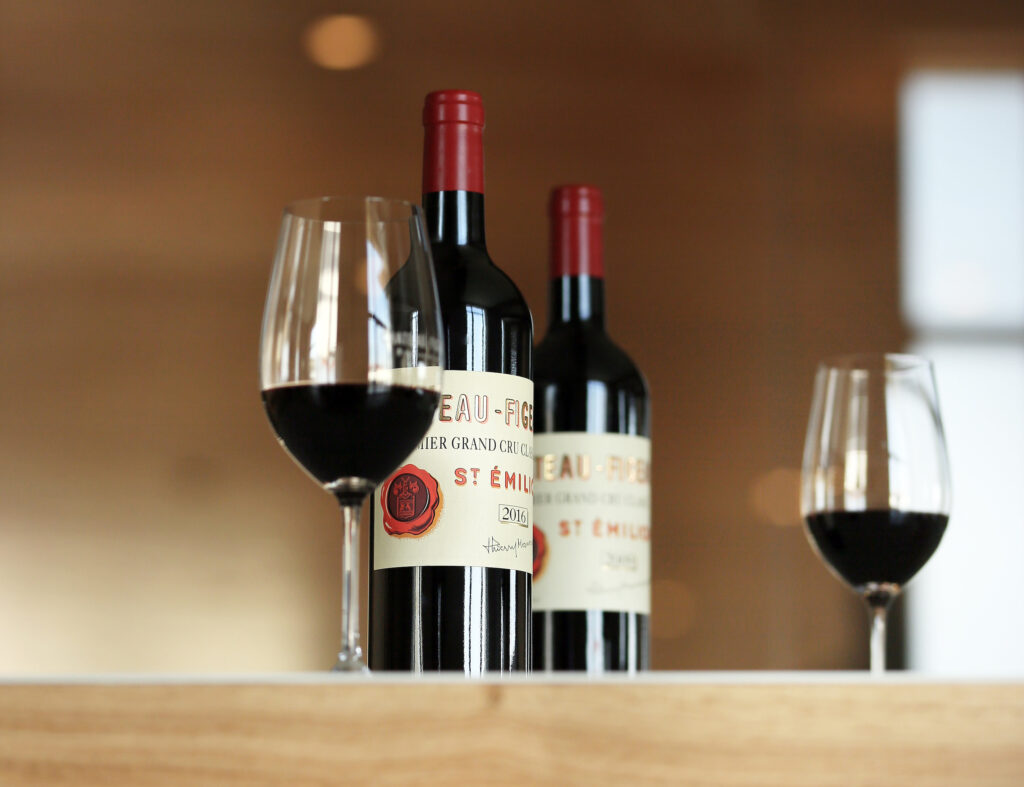We found the convertible to be an improvement on the marque’s initial hybrid, though not as thrilling as its 750S sibling.
McLaren and Monaco have a shared history. The British Formula 1 team has won 15 races here—more than any other constructor, even Ferrari. Five of those victories were with Ayrton Senna, who McLaren honored with a Brazilian-flag livery for its race cars at the 2024 Monaco Grand Prix in May. A one-off McLaren Senna, hand-painted by the McLaren Special Operations division in the same colors, also paid tribute to the famed racer on the 30th anniversary of his death.
In many ways, then, Monaco seems the perfect place to launch the McLaren Artura Spider. Yet the same challenges that make this tiny principality challenging for F1 drivers—cramped streets, tight corners, the near-impossibility of overtaking—also make it manifestly unsuited to supercars. Not that the resident Monagasques seem to mind; judging by the Aston Martin V12 Vantage, Porsche 918 Spyder, and Pagani Huayra parked nearby. Thankfully, McLaren has planned a route for our test drive that climbs swiftly out of Monaco and into the foothills of the French Alps, including sections of the renowned Route Napoleon.
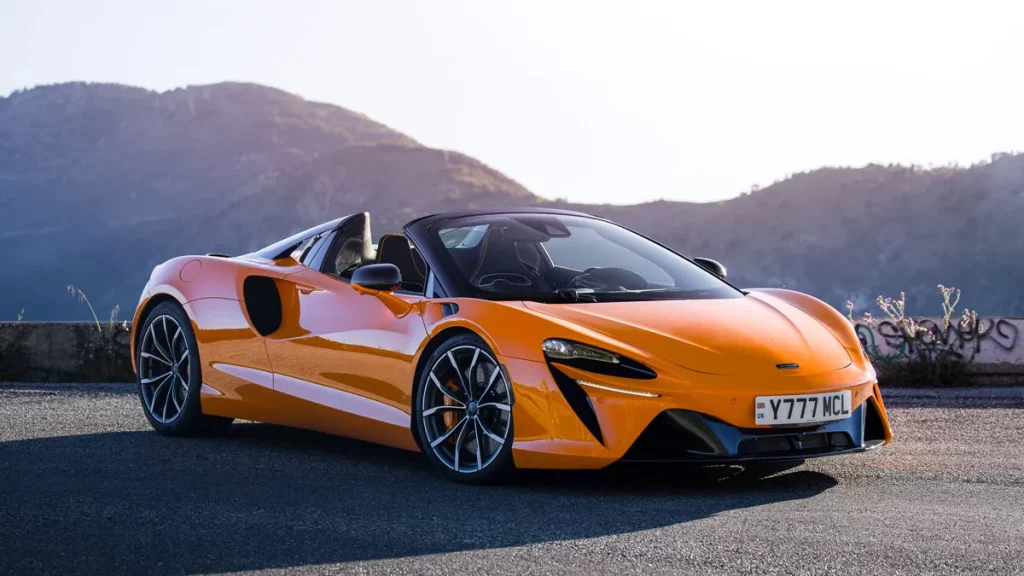
As this is a convertible, our focus first turns to the folding hardtop roof, which is operated by eight electric motors. Made of unpainted carbon composite, it slides near-silently beneath the rear deck in 11 seconds, and will continue to operate at speeds up to 31 mph. If it rains, you can still turn up the six-cylinder volume by retracting the vertical rear window. Our tester also has the optional electrochromic-glass sunroof, which transforms from clear to 99 percent opaque at the push of a button.
With upswept conical tailpipes that are acoustically tuned for a “greater crescendo,” this McLaren roadster also has a recalibrated 3.0-liter twin-turbo V-6 engine that now develops an extra 19 hp compared to the original coupe. Bolstered by a 7.4 kWh battery and an axial-flux electric motor, total output from the plug-in-hybrid power train is 690 hp at 7,500 rpm. And with a curb weight of 3,439 pounds—137 pounds heavier than an Artura coupe—that equates to the convertible variant having a zero-to-60 mph acceleration time of 3.0 seconds and a top speed of 205 mph.
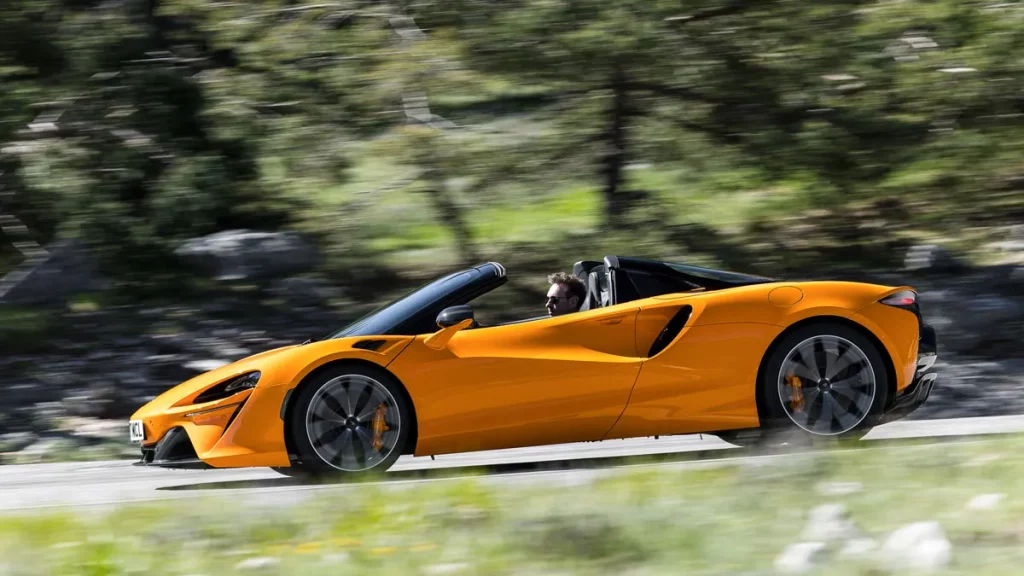
Further tweaks include stiffer engine mounts, new brake-cooling ducts, and a “pre-fill” feature for the eight-speed dual-clutch auto gearbox. Regarding the latter, Michael Norrington, program manager for the model, says, “This pressurizes the hydraulic transmission fluid to what we call the ‘kissing point,’ positioning the clutches as closely together as possible.” According to Norrington, “the result is 25 percent faster shift speeds” compared to the coupe.
With the Artura’s McLaren Carbon Lightweight Architecture (MCLA) platform, the rigid carbon-fiber tub requires no extra reinforcement to compensate for the lack of a fixed roof. Beneath the vehicle’s hot-formed aluminum body panels, however, several changes have been made to the suspension, including new valving for the adaptive shock absorbers and enhanced ethernet architecture to quicken response rates.
Importantly, all of these improvements will be applied to the Artura coupe. Existing Artura owners can also receive the 19 hp boost in output free of charge at McLaren dealers—albeit not the more in-depth upgrades to the car’s transmission and chassis.
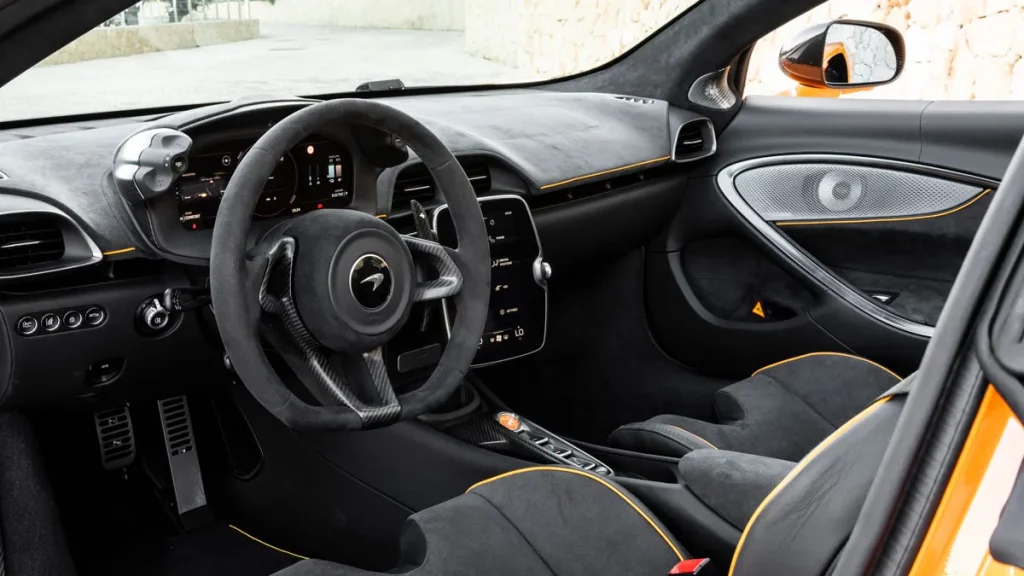
Without a towering wing on its tail, the Artura Spider looks almost understated, well, as much as a supercar dressed in McLaren Orange can be. Design changes for the Spider are focused around its back end. The “hot-vee” engine chimney moves rearwards by eight inches to avoid scorching the folded roof, and there are new air intakes on either side. There are also numerous air-sculpting details, including gurneys atop the windshield frame and tiny winglets on the side mirrors and door handles.
Our example has the hard-shell Clubsport seats, which adjust through an elliptical arc to provide a snug and very comfortable driving position. The cockpit is simple, driver-focused, and swathed in motorsport-style Alcantara—McLaren’s de rigueur interior aesthetic. Chassis and power-train modes are selected by rocker switches within fingertip reach on the instrument binnacle, leaving the steering wheel pleasingly bereft of buttons. Infotainment is via a freestanding touchscreen, now with wired Apple CarPlay connectivity as standard. It won’t wow tech geeks, but unlike Ferrari’s fiddly haptic touchpads, it doesn’t prove an unnecessary distraction.
Despite the marque’s new Spinning Wheel Pull-Away option for the launch control, which allows you to blast off in a swirling cloud of Pirelli smoke, we take off using only battery power, which now offers a longer electric-only range of 21 miles (compared to the 11-mile range of the coupe) before the V-6 kicks in.
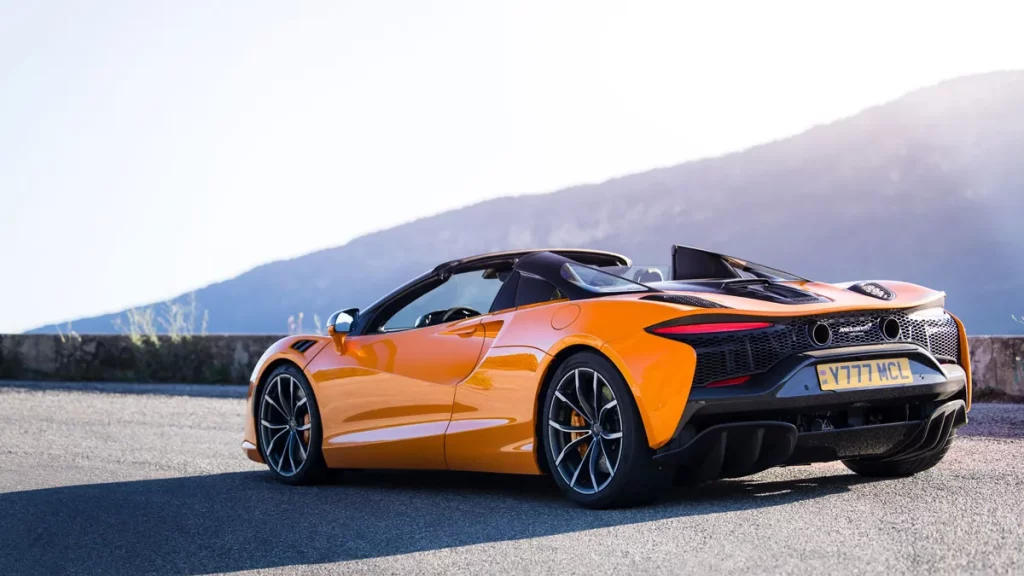
Crossing the border into France, we filter onto the busy autoroute headed towards Nice. Like a Porsche 911 Turbo S, the McLaren can play the long-striding GT car when required, dispatching freeway miles with minimal fuss. One annoyance, though, is the booming resonance that fills the cabin at around 2,000 rpm, though this might be specific to the Sports exhaust fitted here, which uses a symposer to amplify the soundtrack as the revs rise.
Soon, the traffic begins to melt away and the road starts to carve relentlessly up into the low-hanging clouds. It’s time to open the roof and take in the engine’s full voice. While McLaren’s familiar V-8 is all baritone bark and induction whoosh, this engine has a much higher, clearer tenor—culminating in a feral snarl as the needle nears the 8,500 rpm limiter. Back off the throttle and the exhausts burble impatiently, but there are no showboating crackles or bangs, which can be either a positive or negative depending on your preference.
The full 531 ft lbs of torque arrives at just 2,250 rpm, meaning you can frequently short-shift and rely on the ever-present battery boost. The carbon-fiber paddles have a measured, mechanical action that offers some of the tactility of a manual shift. Power delivery is smooth when you take it steady, but nearly instantaneous when you click into Sport or Track mode. Traction from the stock P Zero tires is considerable, and there’s a softer-compound P Zero Corsa available if you plan to take your Artura on the track.
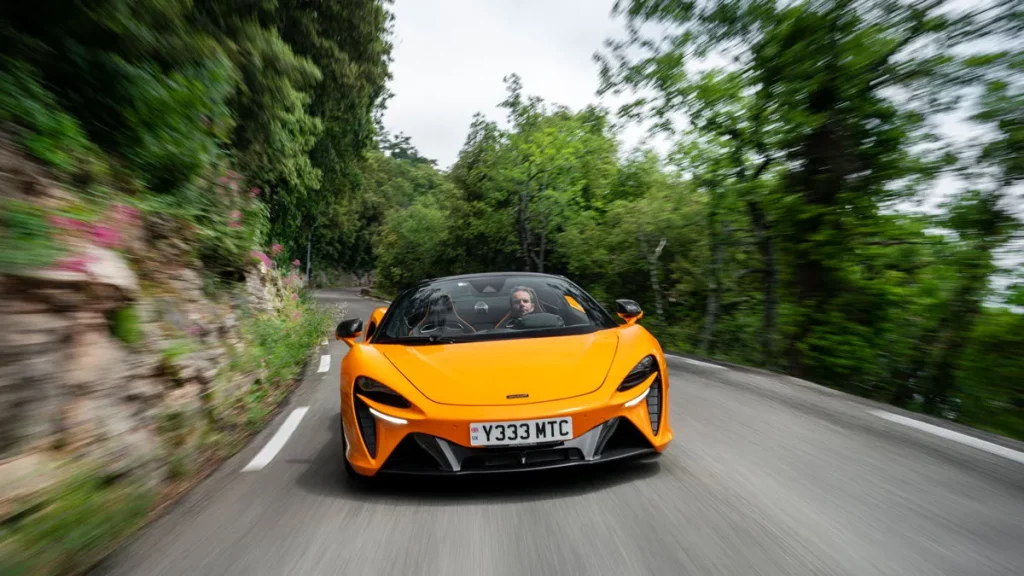
Following the Route Napoleon, a 200-mile ribbon of asphalt with dizzying drops to one side and granite cliffs on the other, the car demonstrates poise and superb balance. Its lightness in the lack of inertia and its carbon-cored rigidity allow it to faithfully respond to driver inputs. Unlike some convertibles, the overall motoring experience doesn’t feel compromised. Due to the nature of the challenging road, though, we don’t even entertain the idea of switching off McLaren’s stability systems or experimenting with its Variable Drift Control.
Two facets of the McLaren’s dynamic repertoire truly stand out. The first is its hydraulic power steering, which offers a vibrancy and level of detail that the electric systems of rival supercars can’t quite match. And the second is its damping, which somehow combines impressive pliancy with iron-fisted body control. To mention another high-end Porsche 911, it bears comparison with the current GT3 RS—high praise indeed.
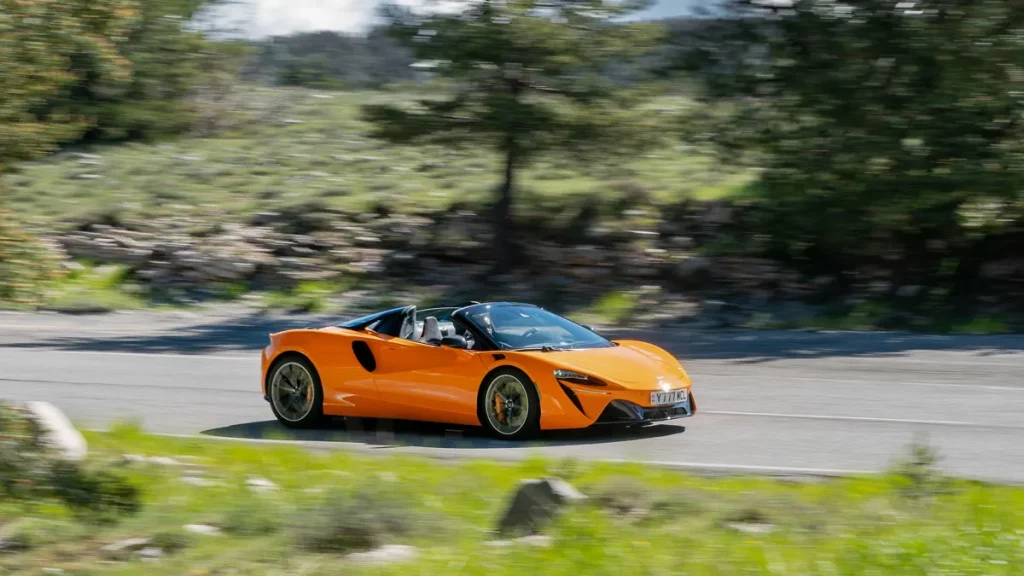
The Artura Spider has its deficiencies, of course. Its brakes could do with more initial bite, even if stopping power from the carbon-ceramic discs isn’t in question. It also lacks the sense of wild abandon that many drivers want from their mid-engined supercar. Case in point: we recently spent a few days with a McLaren 750S Spider and, despite being scarcely quicker than the Artura, it felt like a much fiercer animal—more visceral and exciting. Yet for the Artura, a model that, like the Ferrari 296 GTB, has advanced the pairing of electrification with small but potent internal-combustion engines, this new open-top variant only broadens its appeal.

